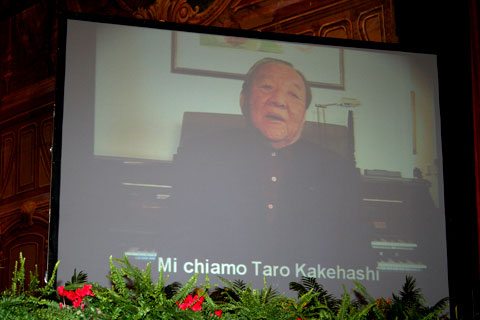
History of the Roland V-Accordion
Around the mid 19th century, an invention consisting of bellows and
a free-reed mechanism appeared in central Europe. A completely new musical
instrument was born: the accordion. This new instrument deeply influenced
the popular music of the time and brought a large number of people closer
to the world of music. To meet the many different demands of the numerous
local musicians, accordions became more and more diverse through the decades,
never resulting in a standardized musical instrument. This meant that
it was practically impossible to make an electronic version of the accordion,
as the instrument would need to consist of a very complicated mechanism
in a cabinet that was still compact and very easy to carry around. In
1967 Ikutaro Kakehashi, the founder of Roland Corporation, a leading manufacturer
of electronic musical instruments, travelled to Italy and had the chance
to meet some accordion craftsmen in the city of Castelfidardo in Le Marche,
known worldwide as the birthplace of the accordion manufacturing industry. In
1967 Ikutaro Kakehashi, the founder of Roland Corporation, a leading manufacturer
of electronic musical instruments, travelled to Italy and had the chance
to meet some accordion craftsmen in the city of Castelfidardo in Le Marche,
known worldwide as the birthplace of the accordion manufacturing industry.
He was so fascinated by this instrument that he bought two accordions to bring home and started to cherish the dream of creating an electronic accordion.  This
dream was also supported by Francesco Rauchi and Luigi Bruti in Roland
Europe S.p.A., members of the Roland Corporation group located in Acquaviva
Picena, in the Marche region. This
dream was also supported by Francesco Rauchi and Luigi Bruti in Roland
Europe S.p.A., members of the Roland Corporation group located in Acquaviva
Picena, in the Marche region.Thanks to the advanced results of their state-of-the-art research and development processes, Roland finally achieved another milestone in the history of digital musical instruments: the V-Accordion, or "Virtual Accordion", equipped with a powerful digital modelling technology. The V-Accordion blends the Italian tradition of musical culture with Japanese cutting edge digital technology, combining Le Marche's traditional accordion craftsmanship with contemporary electronic musical applications. To reach this goal Roland established close relationships with the craftsmen and technicians of the accordion manufacturing companies in Castelfidardo and its surrounding area. Roland was able to perfectly reproduce the accordion sounds by using Roland's unique digital technology, "Physical Behaviour Modelling", which does not alter the way essential components, such as the bellows, are used. Air is still pumped by the bellows in a totally authentic way, but activates a high-definition pressure sensor, instead of reeds. Roland thus designed an innovative accordion without disrupting either its traditional nature or the musical technique required to play it.  As
mentioned above, the accordion is not a standardized musical instrument;
there are different types of accordion for different musical genres and
also for different countries. The V-Accordion can faithfully reproduce
all the various models of traditional accordion, including their different
tuning features. Consequently, you can change a V-Accordion immediately
from an Italian accordion into a French musette, a jazz accordion or a
bandoneon. This means that an accordionist who plays different musical
genres or wants to explore new sound frontiers doesn't need several acoustic
accordions - just one V-Accordion. As
mentioned above, the accordion is not a standardized musical instrument;
there are different types of accordion for different musical genres and
also for different countries. The V-Accordion can faithfully reproduce
all the various models of traditional accordion, including their different
tuning features. Consequently, you can change a V-Accordion immediately
from an Italian accordion into a French musette, a jazz accordion or a
bandoneon. This means that an accordionist who plays different musical
genres or wants to explore new sound frontiers doesn't need several acoustic
accordions - just one V-Accordion.
Thanks to its remarkable flexibility, the V-Accordion can also be configured
in many different ways and also provides easy access to various free-bass
systems from some of the most expensive and heavy accordions. |